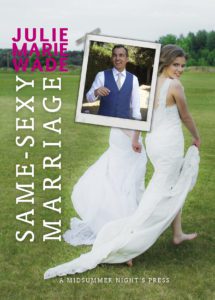
Disclosure: I was probably the wrong reviewer for Same-Sexy Marriage (A Midsummer Night’s Press, April 2018) by Julie Marie Wade, albeit ironically so. Her book captures the spirit of youthful lesbian love in a realm hostile to its existence, while I am an aging lesbian who has given up on love and never desired marriage. I also never felt the deep sting of rejection from family that Wade is recounting in her small book of prose-y poems. Being ambivalent about marriage is not an entirely popular stance—although it’s certainly not mine alone—and I am not so cynical as to be incapable of toasting couples at their weddings, gay or otherwise. And so, slipping out of my typically gloomy garb, I toast this book as deserving of happiness and long-life.
In fact, Same-Sexy Marriage turns out to be only marginally about a lesbian marriage; rather, it is the recounting of bourgeois, heterosexual marriage invented by a mother and adopted by a father—parents for whom the ability to accept having a lesbian daughter is woefully absent, and who use a false story of their daughter’s hetero marriage to deceive their friends and neighbors. It is an hilarious romp about rejection and deception, a story written and re-written from opposing points of view, with scenes of hilarity, poignancy, and near-forgiveness, but ultimately, it is a saga of unforgivable bigotry spitting in the face of lesbian love.
The speaker in this collection is Real Julie, a lesbian whose life choices, including marrying a woman, are so “distasteful” to her parents as to inspire a mammoth lie. The co-narrator is Julie’s mother. Her Fake Julie is married—in “June, of course!”—to a heart surgeon in New England.
Jeffrey Hamilton—it sounded good—the M.D. perched upon his shoulder like a lucky bird.
Fake Julie (the mother’s Julie) grows orchids, plays tennis, and has blue-eyed twins, a boy and a girl. She is “too busy” to travel home to California, and so the grandparents make frequent bogus cross-country trips to Burlington, Vermont, where their daughter lives with her made-up family. But living a falsehood is stressful; deception unfolds upon deception. And when one lie becomes difficult to uphold, the daughter’s family—lickety-split—moves to Boston:
If we have to move—and we really do—the timing couldn’t be better with the twins starting preschool in the fall. They’re quite accelerated, you know.
The story rollicks along, alternating Fake Julie with Real Julie who is living as a lesbian with her chosen life partner. Real Julie has fantasies, too. She has a conversation with Dick Cheney’s lesbian daughter and recalls “Shooting Pool with Anne Heche the Day After Ellen and Portia’s Wedding”:
For starters, the waiter was slow as fuck
bringing our beers, and Heche kept
punching her tiny fist against her pink
splayed palm and muttering,
“Somebody’s about the get clobbered.”
Real Julie is not above retaliatory impulses, noting that Heche is “America’s favorite hasbian,” and that lesbians call it “getting Heched, when a woman you like, or love, leaves you for a man.” But we double down with empathy for the bard of such witticisms, when myths about her lesbian origins—ones that Real Julie’s parents ascribe to—are quoted in the father’s voice in “Mary Cheney, You Know What They Say About Women Like Us”:
This whole homosexuality business got started in the 1960s. Your mother and I got married, then watched the world around us fall to the fornicators and the bigamists, and the sodomites.
It doesn’t get much more real-life than that. The real lesbian couple gets married in Bellingham in 2014, not so far from Seattle, where Fake Julie’s parents live. They are not invited to the wedding for quite obvious reasons, including this one:
They have never once uttered my partner’s name.
And marriage proves no protection from bigotry. Real Julie is denied benefits on her wife’s employment policy, in a letter with the hilarious typo—“same-sexy marriage”—that becomes the book’s title. As a touch of revenge, Fake Julie divorces Jeffrey and sends copies of her very lesbian love poems to her mother’s friends. But then Real Julie offers Fake Julie’s husband an alternative ending—a compassionate divorce where they both go off to become friends who are separately gay.
Ultimately, this is a story in which redemption is not a possibility. Bear in mind: parents like the parents in Same-Sexy Marriage exist, and can cause great harm. And while this book is indeed clever, its cleverness does not shield us from reading the pathos between the lines. Similar stories continue to end not so happily. In this way, Same-Sexy Marriage is a beacon that edifies as much as it amuses. I want to be hopeful that the time is coming (and can’t arrive soon enough!) when it is no big deal to be whomever you turn out to be and love whomever you love. Wade paints us a picture of this future:
Here are eleven friends assembled—one officiating, one reading a poem, another signing as witness to the speaking of vows, the sharing of rings, and two little girls playing pretend-wedding afterwards while no one rushes in to say what our mothers always said—girls can’t marry other girls!
The real Julie Marie Wade, in an afterword, credits her parents for their bequests of “great devotion […], fierce resilience, and strong imagination… .” Throughout Same-Sexy Marriage, Wade shows us the deep compassion she holds onto fiercely, with great devotion, and imagination that is beyond strong, that is brilliant.





